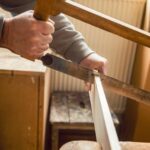Cats are natural climbers and explorers, with an innate need to conquer vertical spaces. While it may be entertaining and amusing to witness their acrobatics, cats climbing on woodwork can cause significant damage.
From scratches and claw marks to potential structural harm, this behavior poses a problem for many cat owners. Understanding the reasons behind this instinctive behavior and learning effective strategies to redirect their climbing habits is essential in maintaining both the integrity of the woodwork and the harmony in your home.
Cats have an inherent desire to climb due to their natural instincts. In the wild, climbing provides them with several advantages such as escaping predators, gaining a better vantage point for hunting, establishing territories, or simply finding a safe spot to relax. To satisfy these instincts, they often seek out vertical surfaces like trees or furniture in human homes. Unfortunately, this can become problematic when they choose delicate woodwork as their preferred climbing spots.
The damage caused by cats climbing woodwork cannot be ignored. Their sharp claws can leave unsightly scratches and claw marks on furniture pieces that are difficult or even impossible to repair. In some cases, persistent climbing may lead to more serious structural damage that weakens the integrity of the woodwork. Whether it’s antique furniture that holds sentimental value or newly installed molding that adds elegance to your living space, protecting your woodwork from cat-induced destruction becomes crucial.
In order to tackle this issue effectively, it is important for cat owners to understand not only the feline nature behind this behavior but also implement appropriate strategies to redirect their climbing urges. Creating alternative climbing spaces that satisfy their instincts while preserving your woodwork is vital. Moreover, utilizing deterrents like double-sided tape or aluminum foil as well as implementing positive reinforcement techniques can discourage cats from scaling forbidden areas while providing mental and physical stimulation elsewhere.
By addressing the underlying causes of why cats climb woodwork and employing practical solutions, cat owners can protect their valuable furnishings, maintain the aesthetics of their homes, and ensure a harmonious living environment for both themselves and their feline companions. Now let’s delve deeper into a cat’s natural instinct to climb and explore, and how it manifests in their affinity for vertical spaces.
Understanding a cat’s natural instinct to climb and explore
Cats are natural climbers and explorers, and their affinity for vertical spaces is rooted in their feline instincts. Understanding this instinctual behavior can help cat owners find effective ways to redirect their climbing tendencies away from woodwork.
Climbing is an innate behavior for cats that serves various purposes. In the wild, cats often climb trees to escape predators, hunt prey, or stake out territory. Domesticated cats retain these instincts, even if their environment may not require them to climb for survival. The act of climbing allows cats to exercise and stretch their muscles, boosts their confidence and sense of security, and provides mental stimulation.
To cater to a cat’s natural instinct to climb and explore, it is important to provide alternative vertical spaces within the home. Cat trees are a popular choice as they offer multiple perching levels and scratching surfaces. These structures allow cats to climb safely while also fulfilling their need to scratch. Wall-mounted perches or shelves strategically placed at different heights can also be utilized as climbing stations.
Additionally, engaging with interactive toys such as puzzle feeders or treat-dispensing devices can encourage cats to explore and climb in a mentally stimulating way. Creating a “catified” environment with plenty of hiding spots, elevated resting areas, and designated play zones can also satisfy a cat’s need for vertical exploration.
In summary, understanding why cats have a natural inclination to climb helps cat owners address this behavior appropriately. By providing alternative climbing spaces such as cat trees or shelves and promoting mental stimulation through interactive toys and environmental enrichment, cat owners can redirect their cats’ climbing tendencies away from woodwork while ensuring that their feline companions remain physically and mentally healthy.
- Provide alternative vertical spaces such as cat trees or shelves.
- Engage with interactive toys like puzzle feeders or treat-dispensing devices.
- Create a “catified” environment with hiding spots, elevated resting areas, and play zones.
Identifying the damage caused by cats climbing woodwork
Woodwork can serve as an attractive climbing option for cats, but it can also result in significant damage to the surfaces and structures. Understanding the potential harm caused by cats climbing woodwork is essential in order to address the issue effectively. This section will highlight the various types of damage that can occur and why it is important to find solutions to prevent cats from engaging in this behavior.
Scratches and Claw Marks
When cats climb on woodwork, their sharp claws can easily leave scratches and claw marks on the surfaces. Over time, this repeated scratching can cause wear and tear, leading to unsightly marks on doors, windowsills, banisters, or furniture. These visible scratches not only diminish the aesthetic appeal of your home but may also require costly repairs or refinishing work.
Potential Structural Damage
Beyond surface scratches, cats climbing on woodwork may pose a risk of causing structural damage. Cats are agile climbers and their weight combined with their active jumping and exploring behavior could put strain on delicate components such as shelves or railings. Over time, this repetitive stress can weaken the structural integrity of the woodwork and potentially lead to breaks or collapses.
The Importance of Addressing the Issue
Allowing cats unrestricted access to climb woodwork not only damages your home’s aesthetics but also compromises its structural stability. Moreover, if left unchecked, this behavior can become habitual for cats and be challenging to correct in the long run. Therefore, it is crucial to address this problem promptly by implementing effective strategies that redirect their climbing behavior towards more appropriate alternatives.
By understanding the potential harm caused by cats climbing woodwork, cat owners can appreciate the urgency of finding solutions to prevent or minimize such damage. The following sections will discuss practical methods to create alternative climbing spaces for cats, utilize deterrents to discourage them from climbing woodwork, provide mental and physical stimulation as well as explore options for seeking professional help and implementing last-resort solutions.
Creating alternative climbing spaces
Cats have a natural instinct to climb and explore their surroundings, which can often lead them to target woodwork in our homes. To prevent this behavior, it is important to provide alternative climbing spaces that fulfill their need for vertical exploration. By offering cat trees, shelves, and wall-mounted perches, owners can redirect their cats’ climbing behavior towards more suitable areas.
A popular option for creating alternative climbing spaces is a cat tree. Cat trees are multi-level structures that provide various platforms and perches for cats to climb on. They often include scratching posts or poles covered in sisal rope, allowing cats to satisfy their natural scratching instincts without damaging woodwork. With different heights and levels, cat trees offer cats the opportunity to climb, jump, and perch at elevated positions, simulating the experience of being in a tree.
Another effective solution is installing shelves specifically designed for cats. These shelves can be mounted on walls at different heights, creating an interesting vertical playground for your feline friend. Not only do they provide cats with elevated vantage points, but they also add a decorative element to your home. Cats will enjoy leaping from one shelf to another or simply lounging on them while observing their surroundings.
Wall-mounted perches are another great option for redirecting your cat’s climbing behavior. These perches can be attached directly to the wall at various heights and offer cozy spots where cats can relax and survey their environment. Wall-mounted perches come in different shapes and sizes, allowing owners to choose ones that best suit their living space and their cat’s preferences.
| Climbing Option | Description | Advantages |
|---|---|---|
| Cat Trees | Multi-level structures with platforms and scratching posts | Provides climbing, scratching, and perching opportunities |
| Shelves | Wall-mounted platforms at different heights | Adds a decorative element while offering climbing and perching options |
| Wall-mounted Perches | Cozy spots attached to walls at various heights | Serves as observation points and resting areas for cats |
By providing these alternative climbing spaces, cat owners can redirect their cats’ natural instinct to climb towards appropriate areas while protecting their woodwork from damage. Integrating these structures into the home environment helps create an enriching and stimulating environment for cats, reducing the likelihood of them seeking out inappropriate climbing surfaces.
Utilizing deterrents
Deterrents can be an effective way to discourage cats from climbing woodwork. There are various tools and techniques that cat owners can use to deter their feline friends from engaging in this behavior. These methods work by making the woodwork unpleasant or uncomfortable for the cat, encouraging them to seek alternative climbing spaces.
One common deterrent is double-sided tape. Cats dislike the sticky feeling on their paws, so placing strips of double-sided tape along the edges of the woodwork can discourage them from climbing. Aluminum foil is another option that can be used as a deterrent. The crinkling sound and texture of foil is often disliked by cats, making it an unattractive surface for them to climb on.
Another method is using citrus scents as a deterrent. Cats generally dislike strong citrus smells, so spraying a citrus-scented spray or placing citrus peels near the woodwork can help keep them away. The smell will discourage them from approaching and climbing on the woodwork.
It’s important to note that while these deterrents may be effective for some cats, others may not be phased by them. Additionally, it’s essential to provide alternative climbing spaces for your cat to redirect their behavior. Providing options such as cat trees, shelves, and wall-mounted perches will give your cat appropriate outlets for their natural instinct to climb and explore.
| Deterrent | Description |
|---|---|
| Double-sided tape | Placing strips of double-sided tape along the edges of woodwork |
| Aluminum foil | Covering areas with crinkled aluminum foil |
| Citrus scents | Spraying citrus-scented spray or placing citrus peels near the woodwork |
Training and behavior modification
Training and behavior modification are essential when it comes to keeping cats from climbing woodwork. It is important to understand that cats climb for a variety of reasons, including the need for exercise, exploration, and marking territories. Instead of punishing them for their natural instincts, it is more effective to redirect their behavior towards appropriate locations.
One effective technique for training cats is positive reinforcement. This involves rewarding desired behaviors and ignoring or redirecting unwanted ones. When it comes to discouraging climbing on woodwork, one approach is to provide alternative climbing spaces that are more suitable for cats.
Cat trees, shelves, and wall-mounted perches can be great options to satisfy their need to climb while protecting your woodwork. By praising and rewarding your cat when they choose these designated areas over the woodwork, they will start associating positive experiences with using those spaces.
Redirecting a cat’s attention away from the woodwork can also be achieved through interactive play sessions and puzzle toys. Engaging your cat in regular playtime not only provides mental stimulation but also helps release pent-up energy that might lead them to climb the woodwork out of boredom. Puzzle toys that dispense treats can keep them occupied while teaching them problem-solving skills at the same time.
Consistency is key when it comes to training and behavior modification. Cats thrive in a structured environment, so setting clear boundaries and consistently reinforcing them will help discourage climbing on woodwork over time. Remember to always provide praise and rewards when your cat chooses the appropriate locations for climbing instead of punishing or scolding them when they make mistakes.
By implementing positive reinforcement techniques and providing appropriate alternatives for climbing, you can effectively train your cat to avoid woodwork while ensuring their natural instincts are satisfied. With patience and persistence, you can create an environment where your cat feels fulfilled and content without damaging your precious wooden surfaces.
Protecting woodwork with physical barriers
One effective method to keep cats from climbing woodwork is by implementing physical barriers. These barriers serve as a clear deterrent and prevent cats from accessing the areas where they may cause damage. There are several options available that can be easily implemented to protect your woodwork.
Sticky Pads
Using sticky pads is one way to discourage cats from climbing on woodwork. These pads have a sticky surface that cats find unpleasant, deterring them from walking or climbing on them.
Sticky pads can be placed strategically along the base of the woodwork or in areas where your cat frequently accesses. It is important to note that you should choose sticky pads specifically designed for feline use to ensure they are safe and do not cause harm to your cat’s paws.
Temporary Fencing
Temporary fencing can be an effective solution in preventing cats from accessing woodwork in certain areas of your home. This can be particularly useful in sections of the house where you want to completely restrict access, such as staircases or doorways leading to rooms with valuable furniture or delicate woodwork.
Temporary fencing can be made using materials like baby gates, lightweight mesh screens, or even DIY solutions like stacked boxes or crates. Ensure that the fencing is secure and high enough so that your cat cannot jump over it.
Plastic Sheeting
Another option for protecting woodwork from cat climbing is using plastic sheeting. By covering the vulnerable areas of the woodwork with plastic sheets, you create a smooth surface that makes it difficult for cats to grip onto and climb up. Securely fasten the plastic sheeting using adhesive tape or clips specific for this purpose, ensuring it does not pose a safety hazard for your cat by coming loose or causing entanglement.
Implementing these physical barriers not only protects your woodwork but also redirects your cat’s climbing behavior towards more appropriate areas. Remember, consistency is key when utilizing these methods. It is important to monitor your cat’s behavior and adjust the barriers as needed. Additionally, providing alternative climbing options like cat trees or shelves can help redirect their natural instinct to climb towards more suitable surfaces.
By implementing physical barriers and providing alternative climbing spaces, you can effectively discourage cats from climbing woodwork while keeping both your cat and your furniture safe. However, if these methods do not yield the desired results, it may be beneficial to seek professional help from a veterinarian or cat behaviorist who can provide additional guidance and suggest last-resort solutions.
Providing mental and physical stimulation
Cats are natural climbers and explorers, so it is crucial to provide them with mental and physical stimulation to keep them entertained and reduce their desire to climb woodwork. One effective way to do this is through engaging playtime.
Regular play sessions not only help satisfy a cat’s instinctual need for hunting but also provide an outlet for excess energy, preventing boredom-induced climbing behavior. Interactive toys such as feather wands, laser pointers, or treat-dispensing puzzle toys can be used during play sessions to mentally stimulate cats and keep them engaged.
In addition to playtime, puzzle toys can be especially beneficial in providing mental stimulation for cats. These toys challenge their problem-solving skills and keep their minds active.
There are a variety of puzzle toys available on the market that are specifically designed for cats, such as treat puzzles where they have to figure out how to retrieve treats from hidden compartments. By keeping their minds occupied with these stimulating activities, cats are less likely to engage in destructive behaviors like climbing woodwork.
Another great way to provide both mental and physical stimulation for cats is by creating an enriched environment with various interactive activities. Consider setting up a designated “cat room” or area in your home where you can place scratching posts, tunnels, elevated perches, and hiding spots.
This allows cats to engage in natural behaviors like scratching, jumping, and exploring in a safe and controlled environment. You can also rotate the placement of interactive toys and provide new stimuli regularly to keep things interesting for your cat.
Remember that each cat is unique when it comes to their preferences for play and interaction, so it may take some trial and error before finding the activities that truly engage your furry friend. Taking the time to understand your cat’s individual needs and preferences will help create an enriched environment that keeps them mentally stimulated and reduces their desire to climb woodwork.
By incorporating regular engaging playtime, puzzle toys, and interactive activities into their daily routine, you can provide your cat with the mental and physical stimulation they need while also safeguarding your woodwork.
Seeking professional help and implementing last-resort solutions
While there are many effective techniques and strategies for deterring cats from climbing woodwork, some stubborn felines may persist despite the owner’s best efforts. In such cases, seeking professional help can be a valuable option. If all other methods have failed to prevent a cat from climbing woodwork, it is advisable to consult with a veterinarian or a certified cat behaviorist for expert guidance.
Veterinarians can provide insights into the underlying causes of the unwanted behavior and recommend suitable solutions. They may conduct a thorough physical examination to rule out any medical conditions that could be contributing to the cat’s climbing behavior. Additionally, they can offer advice on diet and exercise, as well as suggest anti-anxiety medications or pheromone sprays that may help reduce the cat’s desire to climb furniture and woodwork.
Cat behaviorists, on the other hand, specialize in understanding feline behavior and can provide customized training plans based on individual cats and their specific needs. These professionals can assess the environmental factors that contribute to climbing behaviors and make appropriate recommendations for modifying the home environment. They may also suggest behavioral modification techniques that include positive reinforcement training to redirect the cat’s attention towards more appropriate locations for climbing.
It’s important to remember that seeking professional help should not be seen as a failure but rather as an opportunity to address the issue with expert guidance. A veterinarian or a certified cat behaviorist can support owners in finding effective last-resort solutions tailored specifically to their cat’s needs.
With their expertise, individuals will be empowered with new strategies to discourage their cats from climbing woodwork while fostering a safe and harmonious living environment for both humans and their feline companions.
Conclusion and final tips
In conclusion, keeping cats from climbing woodwork can be achieved through a combination of understanding their natural instinct to climb, providing alternative climbing spaces, utilizing deterrents, training and behavior modification, implementing physical barriers, and providing mental and physical stimulation. By following these strategies, cat owners can effectively protect their woodwork from potential damage while also ensuring the safety and well-being of their feline companions.
One important aspect to remember is the importance of redirecting a cat’s climbing behavior towards appropriate locations. By providing cat trees, shelves, or wall-mounted perches, owners can offer vertical spaces that fulfill a cat’s need to climb and explore. Additionally, engaging in playtime activities and using puzzle toys can help keep cats mentally and physically stimulated, reducing their desire to climb on woodwork out of boredom or frustration.
It is also crucial to consider seeking professional help if all other methods fail. Consulting with a veterinarian or cat behaviorist can provide expert guidance on addressing any underlying issues that may be causing excessive climbing behavior. In some cases, anti-anxiety medications or pheromone sprays may be necessary to help calm cats and discourage them from climbing woodwork.
Ultimately, by employing a combination of these strategies and staying consistent with training efforts, cat owners can enjoy a harmonious living space while ensuring the safety of their cats and preservation of their woodwork. With patience and perseverance, it is possible to create an environment where cats are content without resorting to destructive climbing habits.
Frequently Asked Questions
How do you stop cats from clawing woodwork?
To prevent cats from clawing woodwork, there are a few strategies you can try. First, provide your cat with appropriate scratching alternatives such as sturdy scratching posts or boards covered with materials like sisal rope or carpet. Place these near the woodwork they frequently target, enticing them to scratch there instead. Secondly, deter your cat by using deterrent sprays or double-sided tape on the targeted areas.
Cats generally dislike sticky textures and scents, so this can discourage them from clawing the woodwork. Additionally, you could cover the woodwork temporarily with aluminum foil or plastic sheets until your cat learns not to scratch those surfaces. It’s crucial to ensure that your cat receives enough physical and mental stimulation through play and interactive toys as well since boredom may lead to excessive scratching.
How do I stop my cat from climbing trim?
If your cat loves climbing trim, there are a few steps you can take to redirect their behavior. Firstly, providing alternative climbing options is vital. Consider investing in a sturdy and tall cat tree or creating vertical spaces for them with shelves or platforms where they can climb and perch comfortably while enjoying a view.
Encourage your cat to use these preferred spots by placing treats or toys up high. Moreover, if the trim is located near a window that attracts your cat’s attention, blocking their access to it by closing curtains or blinds might help redirect their climbing behavior away from the trim.
How do I keep my cat from climbing my cabinets?
To prevent your cat from climbing cabinets, it’s necessary to make these areas less appealing and inaccessible to them while providing alternative options nearby. Start by ensuring your cat has ample opportunities for vertical exploration by offering tall furniture like cat trees or installing wall-mounted perches and shelves within their reach. Additionally, you can try using deterrents such as sticky mats on top of cabinets to make those surfaces undesirable for climbing attempts due to the uncomfortable texture they create for cats’ paws.
It may also be helpful to keep cabinet doors closed at all times using childproof latches or magnets until your cat learns not to climb on them. Redirecting their attention towards toys, interactive games, or treats placed on alternative surfaces can further discourage them from scaling the cabinets. Regularly providing mental and physical stimulation through play sessions will also alleviate any potential boredom that may contribute to this behavior.

Hi everyone! I’m a woodworker and blogger, and this is my woodworking blog. In my blog, I share tips and tricks for woodworkers of all skill levels, as well as project ideas that you can try yourself.





